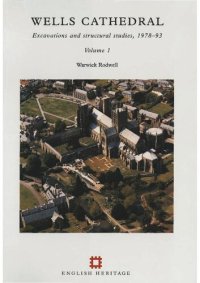
Ebook: Wells Cathedral: Excavations and Structural Studies, 1978-93. Vol. 1. Part 1. Historical and Structural Sequence. Vol. 2. Part 2. Specialist Studies: Artefacts and Burials
Author: Warwick Rodwell
- Genre: History // Archaeology
- Series: English Heritage Archaeological Reports 21
- Year: 2001
- Publisher: English Heritage
- City: Swindon
- Language: English
- pdf
With contributions by Marion M. Archibald, Elisabeth Crowfoot, Paul Drury, Brian Gittos, Moira Gittos, Jill Kerr, Juliet Rogers, Vince Russett, Jerry Sampson, Alan Saville and Jeffrey West, and a Foreword by Patrick Mitchell.
Ebook (PDF) published 2013.
Archaeological excavation, architectural survey and historical research carried out between 1978 and 1993 have elucidated the origins and early development, of Wells Cathedral. Study concentrated primarily on the cloister and its adjuncts, and excavation took place in the adjoining 'Camery' garden. Here lay an ancient cemetery and the foundations of a succession of demolished buildings, ranging in date from Roman to post-medieval. Collectively, these enshrined a continuous development of religious and sepulchral activity, probably from the fourth to the mid-sixteenth century; secular uses followed. Adjacent to the Camery are the springs from which Wells takes its name. The first mention of the 'holy well' and minster church of St Andrew is in A.D. 766. Excavation yielded a complex stratigraphic sequence, demonstrating how an anonymous late Roman mausoleum burial probably provided the 'raison d'être' for the development of a Middle Saxon cemetery and chapel, and hence for the origins of Wells Cathedral itself in 909. The establishment of this sequence is uniquely important in the history of English cathedral archaeology and sets Wells alongside developments in continental Europe.
Ebook (PDF) published 2013.
Archaeological excavation, architectural survey and historical research carried out between 1978 and 1993 have elucidated the origins and early development, of Wells Cathedral. Study concentrated primarily on the cloister and its adjuncts, and excavation took place in the adjoining 'Camery' garden. Here lay an ancient cemetery and the foundations of a succession of demolished buildings, ranging in date from Roman to post-medieval. Collectively, these enshrined a continuous development of religious and sepulchral activity, probably from the fourth to the mid-sixteenth century; secular uses followed. Adjacent to the Camery are the springs from which Wells takes its name. The first mention of the 'holy well' and minster church of St Andrew is in A.D. 766. Excavation yielded a complex stratigraphic sequence, demonstrating how an anonymous late Roman mausoleum burial probably provided the 'raison d'être' for the development of a Middle Saxon cemetery and chapel, and hence for the origins of Wells Cathedral itself in 909. The establishment of this sequence is uniquely important in the history of English cathedral archaeology and sets Wells alongside developments in continental Europe.
Download the book Wells Cathedral: Excavations and Structural Studies, 1978-93. Vol. 1. Part 1. Historical and Structural Sequence. Vol. 2. Part 2. Specialist Studies: Artefacts and Burials for free or read online
Continue reading on any device:

Last viewed books
Related books
{related-news}
Comments (0)